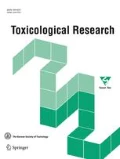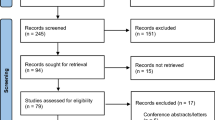Abstract
During the last years, several reports have provided evidence about adverse health effects on personal involved in Antineoplastic Drugs (ANPD) handling. ANPD has the ability to bind DNA, thus produce genotoxic damage. In this way, XRCC1 and XRCC3 proteins are necessary for efficient DNA repair and polymorphisms in this genes can be associated with an individual response to ANPD exposure. Therefore, the aim of this study was to evaluate genetic damage of occupational exposure to antineoplastic drugs and the possible effect of XRCC1 and XRCC3 polymorphisms in oncology employees from Bogotá, Colombia. Peripheral blood samples were obtained from 80 individuals, among exposed workers and healthy controls. The comet assay and Cytokinesis-block micronucleus cytome assay was performed to determinate genetic damage. From every sample DNA was isolated and genotyping for XRCC1 (Arg194Trp, Arg280His and Arg399Gln) and XRCC3 (Thr241Met) SNPs by PCR–RFLP. The exposed group showed a significant increase of comet assay results and micronucleus frequency, compared with unexposed group. It was observed a gender, exposure time and workplace effect on comet assay results. Our results showed no significant associations of comet assay results and micronucleus frequency with either genotype, allele, nor haplotype of XRCC1 and XRCC3 SNPs. The results suggest that occupational exposure to ANPD may lead to genotoxic damage and even be a risk to human health. To our knowledge, this is the first study to assess the genotoxic damage of occupational exposure to APND in South America.

Similar content being viewed by others
References
Buschini A, Villarini M, Feretti D, Mussi F, Dominici L, Zerbini I, Moretti M, Ceretti E, Bonfiglioli R, Carrieri M, Gelatti U, Rossi C, Monarca S, Poli P (2013) Multicentre study for the evaluation of mutagenic/carcinogenic risk in nurses exposed to antineoplastic drugs: assessment of DNA damage. Occup Eviron Med 70:789–794
Izdes S, Sardas S, Kadioglu E, Kaymak C, Ozcagli E (2009) Assessment of genotoxic damage in nurses occupationally exposed to anaesthetic gases or antineoplastic drugs by the comet assay. J Occup Health 51:283–286
King J, Alexander M, Byrne J, MacMillan K, Mollo A, Kirsa S, Green M (2016) A review of the evidence for occupational exposure risks to novel anticancer agents—a focus on monoclonal antibodies. J Oncol Pharm Pract 22:121–134
Suspiro A, Prista J (2011) Biomarkers of occupational exposure do anticancer agents: a minireview. Toxicol Lett 207:42–52
Villarini M, Gianfredi V, Levorato S, Vannini S, Salvatori T, Moretti M (2016) Occupational exposure to cytostatic/antineoplastic drugs and cytogenetic damage measured using the lymphocyte cytokinesis-block micronucleus assay: a systematic review of the literature and meta-analysis. Mutat Res 770:35–45
Cornetta T, Padua L, Testa A, Ievoli E, Festa F, Tranfo G, Baccelliere L, Cozzi R (2008) Molecular biomonitoring of a population of nurses handling antineoplastic drugs. Mutat Res 638:75–82
Ladeira C, Viegas S, Carolino E, Gomes MC, Brito M (2013) The influence of genetic polymorphisms in XRCC3 and ADH5 genes on the frequency of genotoxicity biomarkers in workers exposed to formaldehyde. Environ Mol Mutagen 54:213–221
Sorsa M, Anderson D (1996) Monitoring of occupational exposure to cytostatic anticancer agents. Mutat Res 355:253–261
Hong SH, Szili EJ, Fenech M, Gaur N, Short RD (2017) Genotoxicity and cytotoxicity of the plasma jet-treated medium on lymphoblastoid WIL2-NS cell line using the cytokinesis block micronucleus cytome assay. Sci Rep 7:3854
Gajski G, Geric M, Orescanin V, Garaj-Vrhovac V (2018) Cytokinesis-block micronucleus cytome assay parameters in peripheral blood lymphocytes of the general population: contribution of age, sex, seasonal variations and lifestyle factors. Ecotox Environ Saf 148:561–570
Fenech M (2006) Cytokinesis-block micronucleus assay evolves into a “cytome” assay of chromosomal instability, mitotic dysfunction and cell death. Mutat Res 600:58–66
Jacociunas LV, de Andrade HH, Lehmann M et al (2013) Artichoke induces genetic toxicity in the cytokinesis-block micronucleus (CBMN) cytome assay. Food Chem Toxicol 55:56–59
Araujo FD, Pierce AJ, Stark JM, de Abreu BR, Ferraz AB, da Silva J, Grivicich I, Dihl RR (2002) Variant XRCC3 implicated in cancer is functional in homology-directed repair of double-strand breaks. Oncogene 21:4176–4178
Fenech M (2007) Cytokinesis-block micronucleus cytome assay. Nat Protoc 2:1084–1104
Lee SL, Thomas P, Hecker J, Faunt J, Fenech M (2015) Chromosomal DNA damage measured using the cytokinesis-block micronucleus cytome assay is significantly associated with cognitive impairment in South Australians. Environ Mol Mutagen 56:32–40
Villalba-Campos M, Chuaire-Noack L, Sanchez-Corredor MC, Rondon-Lagos M (2016) High chromosomal instability in workers occupationally exposed to solvents and paint removers. Mol Cytogenet 9:46
Tice RR, Agurell E, Anderson D, Burlinson B, Hartmann A, Kobayashi H, Miyamae Y, Rojas E, Ryu JC, Sasaki YF (2000) Single cell gel/comet assay: guidelines for in vitro and in vivo genetic toxicology testing. Environ Mol Mutagen 35:206–221
Muñoz Aristizábal AF (2009) Assesment of DNA damage in two colombian populations of agricultirist and floriculturist. Rev UDCA Act Div Cient 1:7–16
Wang Q, Ji F, Sun Y, Qiu YL, Wang W, Wu F, Miao WB, Li Y, Brandt-Rauf PW, Xia ZL (2010) Genetic polymorphisms of XRCC1, HOGG1 and MGMT and micronucleus occurrence in Chinese vinyl chloride-exposed workers. Carcinogenesis 31:1068–1073
Mandal RK, Mittal RD (2018) Polymorphic variation in double strand break repair gene in indian population: a comparative approach with worldwide ethnic group variations. Indian J Clin Biochem 33:184–189
Maluf SW, Erdtmann B (2000) Follow-up study of the genetic damage in lymphocytes of pharmacists and nurses handling antineoplastic drugs evaluated by cytokinesis-block micronuclei analysis and single cell gel electrophoresis assay. Mutat Res 471:21–27
Moretti M, Grollino MG, Pavanello S, Bonfiglioli R, Villarini M, Appolloni M, Carrieri M, Sabatini L, Dominici L, Stronati L, Mastrangelo G, Barbieri A, Fatigoni C, Bartolucci GB, Ceretti E, Mussi F, Monarca S (2015) Micronuclei and chromosome aberrations in subjects occupationally exposed to antineoplastic drugs: a multicentric approach. Arch Environ Occup Health 88:683–695
Zhang Z, Wan J, Jin X, Jin T, Shen H, Lu D, Xia Z (2005) Genetic polymorphisms in XRCC1, APE1, ADPRT, XRCC2, and XRCC3 and risk of chronic benzene poisoning in a Chinese occupational population. Cancer Epidemiol Biomark Prev 14:2614–2619
Laffon B, Teixeira JP, Silva S, Loureiro J, Torres J, Pasaro E, Mendez J, Mayan O (2005) Genotoxic effects in a population of nurses handling antineoplastic drugs, and relationship with genetic polymorphisms in DNA repair enzymes. Am J Ind Med 48:128–136
Ladeira C, Viegas S, Padua M, Gomes M, Carolino E, Gomes MC, Brito M (2014) Assessment of genotoxic effects in nurses handling cytostatic drugs. J Toxicol Environ Health A 77:879–887
El-Ebiary AA, Abuelfadl AA, Sarhan NI (2013) Evaluation of genotoxicity induced by exposure to antineoplastic drugs in lymphocytes of oncology nurses and pharmacists. J App Toxicol 33:196–201
Villarini M, Dominici L, Fatigoni C, Muzi G, Monarca S, Moretti M (2012) Biological effect monitoring in peripheral blood lymphocytes from subjects occupationally exposed to antineoplastic drugs: assessment of micronuclei frequency. J Occup Health 54:405–415
Hessel H, Radon K, Pethran A, Maisch B, Grobmair S, Sautter I, Fruhmann G (2001) The genotoxic risk of hospital, pharmacy and medical personnel occupationally exposed to cytostatic drugs—evaluation by the micronucleus assay. Mutat Res 497:101–109
Mayer PJ, Lange CS, Bradley MO, Nichols WW (1991) Gender differences in age-related decline in DNA double-strand break damage and repair in lymphocytes. Ann Hum Biol 18:405–415
Uppstad H, Osnes GH, Cole KJ, Phillips DH, Haugen A, Mollerup S (2011) Sex differences in susceptibility to PAHs is an intrinsic property of human lung adenocarcinoma cells. Lung Cancer 71:264–270
Fenech M, Bonassi S (2011) The effect of age, gender, diet and lifestyle on DNA damage measured using micronucleus frequency in human peripheral blood lymphocytes. Mutagenesis 26:43–49
Kopjar N, Garaj-Vrhovac V, Kasuba V, Rozgaj R, Ramic S, Pavlica V, Zeljezic D (2009) Assessment of genotoxic risks in Croatian health care workers occupationally exposed to cytotoxic drugs: a multi-biomarker approach. Int J Hyg Environ Health 212:414–431
Cornetta T, Festa F, Testa A, Cozzi R (2006) DNA damage repair and genetic polymorphisms: assessment of individual sensitivity and repair capacity. Int J Radiat Oncol Biol Phys 66:537–545
Moretti M, Bonfiglioli R, Feretti D, Pavanello S, Mussi F, Grollino MG, Villarini M, Barbieri A, Ceretti E, Carrieri M, Buschini A, Appolloni M, Dominici L, Sabatini L, Gelatti U, Bartolucci GB, Poli P, Stronati L, Mastrangelo G, Monarca S (2011) A study protocol for the evaluation of occupational mutagenic/carcinogenic risks in subjects exposed to antineoplastic drugs: a multicentric project. BMC Public Health. 11:195
Iarmarcovai G, Sari-Minodier I, Chaspoul F, Botta C, De Meo M, Orsiere T, Berge-Lefranc JL, Gallice P, Botta A (2005) Risk assessment of welders using analysis of eight metals by ICP-MS in blood and urine and DNA damage evaluation by the comet and micronucleus assays; influence of XRCC1 and XRCC3 polymorphisms. Mutagenesis 20:425–432
Bull CF, Mayrhofer G, Zeegers D, Mun GL, Hande MP, Fenech MF (2012) Folate deficiency is associated with the formation of complex nuclear anomalies in the cytokinesis-block micronucleus cytome assay. Environ Mol Mutagen 53:311–323
Skjelbred CF, Saebø M, Wallin H, Nexø BA, Hagen PC, Lothe IM, Aase S, Johnson E, Hansteen IL, Vogel U, Kure EH (2006) Polymorphisms of the XRCC1, XRCC3 and XPD genes and risk of colorectal adenoma and carcinoma, in a Norwegian cohort: a case control study. BMC Cancer 6:67–76
Cho NY, Kim KW, Kim KK (2017) Genomic health status assessed by a cytokinesis-block micronucleus cytome assay in a healthy middle-aged Korean population. Mutat Res 814:7–13
Francois M, Hochstenbach K, Leifert W, Fenech MF (2014) Automation of the cytokinesis-block micronucleus cytome assay by laser scanning cytometry and its potential application in radiation biodosimetry. Biotechniques 57:309–312
Acknowledgements
The authors gratefully acknowledge the cooperation of all volunteers who participated in this study and support of “Asociación de Enfermería Oncológica Colombiana”.
Author information
Authors and Affiliations
Corresponding author
Ethics declarations
Conflict of interest
The authors have no conflicts of interest to declare.
Rights and permissions
About this article
Cite this article
Aristizabal-Pachon, A.F., Castillo, W.O. Genotoxic evaluation of occupational exposure to antineoplastic drugs. Toxicol Res. 36, 29–36 (2020). https://doi.org/10.1007/s43188-019-00003-7
Received:
Revised:
Accepted:
Published:
Issue Date:
DOI: https://doi.org/10.1007/s43188-019-00003-7



